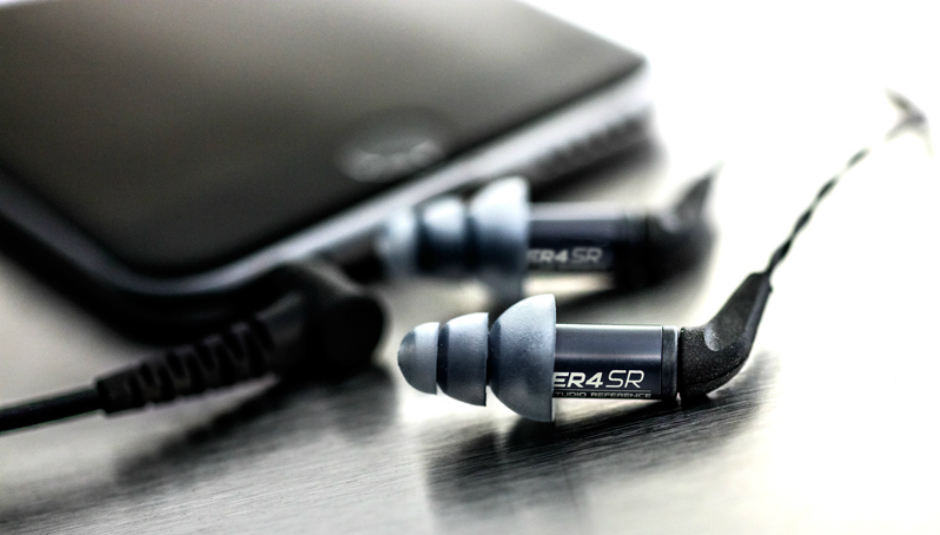Forget about the cheap white buds that come with your iPhone, everyone knows that if you really want to hear your music, you're gonna need to invest in a better set of earphones. But the market is as wide as it is diverse; in-ears, over-ears, noise-canceling, wireless...the choice is seemingly endless. And with even some high-end, expensive brands sacrificing substance for style - with a price tag to match - it's hard to know exactly where to turn to maximise your personal listening enjoyment.
For many, Etymotic have long been a gold standard of sorts, producing high fidelity earphones of unparalleled excellence for over 30 years. The company actually invented the first in-ear model, and have been at the cutting edge of audio technology and advancement ever since. Their ER-4, considered a classic among committed audiophiles and billed as "the world’s most accurate high-fidelity, noise-isolating earphone", has recently been updated; the first change to the model in 25 years.
Aimed at studio users and those using some serious audio gear - one fan I spoke to actually carried around a mini DAC, which he ran his iPod through - they have the specs and the price tag to match; these are not aimed at the casual jogger or Youtube fan. That being said, even poor quality MP3's sound good through the ER4SR, while high-quality recordings sound absolutely glorious. DiS sat down with Patty Johnson, AuD, Director of Audiology at Etymotic, to talk about the technology behind the update, people's listening habits, and whether audio perfection will ever be achieved.
DiS: What prompts the decision to update a model, or to try and improve it, as with the ER4’s? Is there a tipping point when you think enough of an improvement can be made to justify a new model, like the ER4?
Patty Johnson: The ER-4 earphones, recognized by critical listeners - musicians, sound engineers, and audiophiles - as the most accurate earphones in the world, were developed over 20 years ago. Etymotic’s founder, Dr. Mead Killion, developed these earphones based on a knowledge of the acoustics of sound and the acoustics of the human ear. The longevity of the ER-4 in the marketplace speaks to the success of the original design. The only serious complaint we’ve received about the original ER-4s is that of cable breakage after years of heavy use. While Etymotic provides repairs, even on ER-4s that are decades old, the availability of new materials allowed us to create a cable design that could be replaced by the user, so those who rely on these earphones can quickly replace a worn cable without returning the earphones to us.
What specific things did you do with the earphones this time, and how noticeable a change is it from the old model?
The ER-4S provided the most accurate sound reproduction (92%), but its 100-ohm impedance required the use of an external amplifier for some applications. The ER-4PT, at 27 ohms impedance, worked well with portable players but was slightly less accurate (86%). The ER4SR gives users the best of both worlds: lower impedance (45 ohms) and greater accuracy (92%) all in the same package. New models also have anodized, laser-etched aluminum bodies and reinforced user-replaceable (detachable) cables.
Why have the XR [Extended Response] version, and who would benefit from using them?
Over the years, some users have expressed the desire for a little extra presence in the lower end without compromising the accuracy in the midrange and high frequencies. The ER4XR is ideal for those who want exceptional accuracy with a bit of low-end enhancement.
One thing I noticed from using them is the “space” that they give the music. A lot of in-ears seem to compress the music, so everything sounds muddled together, but with these, you can really pick out details and nuances. How do you achieve that?
Our in-ear design is rather unique in that the shape of our earphones and eartips create a very deep seal in the ear canal. Not only does this provide superior noise isolation, but it also allows the listener to hear things in their recordings they may have never heard before. It becomes much easier to pick up new details when you’ve blocked out the ambient competition for your ears. We design our products for accuracy when it comes to sound reproduction. Many earphones on the market tend to hype bass or treble levels; we take a more scientific approach. Manufacturing to our target frequency response curve allows the listener to hear music exactly as intended by the sound engineer.
How do you cope with the fact that everyone’s ears are different, and have different sensitivities? Presumably, the way one person hears something is not the same as another?
The name “Etymotic” means “true to the ear.” In terms of earphone sound reproduction, our goal is to reproduce sound as it would be heard in the live situation. Imagine you’re in your home with a group of friends, listening to your favorite music on your stereo system. Every person’s ears are slightly different, but the music is the music. Our earphones reproduce sound as close to the original as possible—so users will hear what they would in the live situation, with all nuances preserved.
Etymotic invented the first “scientific sound quality measurement”. What exactly are you trying to measure, and how do you go about it?
In the 1970s, the Consumers Union used an “Accuracy Score” to rate loudspeakers, and reported that listener’s loudspeaker ratings could be predicted within 8% using a calculation based on one-third octave frequency response measurements, converted to loudness in sones. The average error in loudness from a perfect system, subtracted from 100%, gives the accuracy score. Etymotic Research extended this 21-band calculation to a 25-band calculation, and uses the 25-band accuracy scores in all our earphone designs. We routinely test competitive products, and the accuracy scores of Etymotic earphones are higher than all other earphones we’ve tested, with the exception of electrostatic headphones costing thousands of dollars.
A lot of people might say that with streaming services, and 128kbps MP3 files, an expensive pair of headphones like these are a little pointless. Can they add to the day to day listening experience of normal users, or are they far better suited to a studio and recording artists and audiophiles?
Etymotic has earphones at price points for every listener, including safe-listening earphones for children and safety earphones for individuals who work in noisy environments. Our entire earphone line has two significant advantages: high external noise isolation and high-fidelity sound reproduction. Our earphones are made to seal the ear (like earplugs), reducing outside noise by as much as 98% (the highest of any earphones or headsets on the market today). Passive isolation has several advantages: 1) it doesn’t require batteries; 2) it allows for smaller, lighter earphones; and 3) users can hear better at lower playback levels, so there’s no need to raise the volume to unsafe levels to hear. Passive isolation, combined with our exceptional accuracy, produce a response in which even the average listener will hear things in their music that they haven’t heard before. It’s truly an entirely new listening experience. One caveat about the isolation is that users need to be mindful of their environment, and not use noise-reduction or noise-isolating earphones where hearing environmental sounds is critical to safety.
Essentially, what it is you are trying to replicate with earphones/ the sound of studio monitors? The sound of live music? Is it more a “technical” question than one of feeling?
Our earphones are designed to reproduce sound as close to the original as possible, without coloring or altering the sound. This accuracy is what makes them so desirable to critical listeners.
Do you think there are endless improvements to be made when it comes to earphones and sound reproduction, or eventually one day someone will produce the perfect pair, that perfectly replicates what you want?
The last part of your question is key: “perfect pair” defined as “perfectly replicating what you want.” In that scenario, the definition of “perfect” is open to individual interpretation. The physics of sound and the physics of the ear canal don’t change, and our goal is to reproduce the sound as it was intended to be heard by the artist and the recording engineer who created it. Our accuracy scores reflect that. We don’t color or change the soundscape; we respect the original recording. Other facets of technology, such as customization of fit to the ear and the devices we use to store and play sound, will undoubtedly change in the future, and earphone design will likely also change to remain compatible.
For more information about Etymotic earphones, and to view their entire range, please visit their official website.























